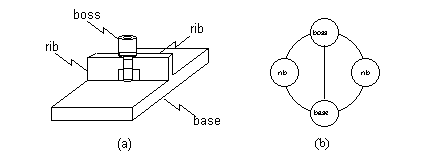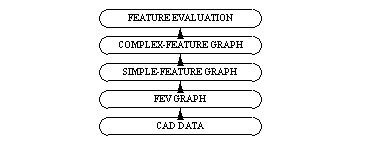6.2 FEATURE SPECIFICATION
6.2.1 SIMPLE-FEATURE GRAPHS
A simple-feature graph uses nodes to represent features and non-directed links to indicate topological relationships. These links could be labeled to describe the specific type of topological relation, thereby providing an augmented simple-feature graph. The nodes themselves index to geometric property information about the represented feature. Figure 62 (a) below illustrates the representation of a geometric artifact and labels salient features. Figure 62 (b) illustrates the feature graph of the same part after feature abstraction.
Figure 62 Artifact and its Simple-Feature Graph Representation

A tabulation and analysis of complex features within the domain of plastic injection molding has indicated that a limited set of simple forms and their attributes may be sufficient to build and describe the complex features. Table 6 on page 49 lists the rudimentary set of simple forms required: rib, boss, blind hole, through hole, slot, and base. These forms, their properties to be described below, and a graph of their connections should be fully sufficient to describe all possible combinations that currently exist and will exist in the future.
In a previous section it was seen how CAD data of surface information was abstracted into a face-edge-vertex graph (FEV) graph, and how the FEV graph is further abstracted into a simple feature graphs. The next step is the abstraction of complex features for evaluation. Figure 63 depicts how CAD information is structured in these successive layers of abstraction. At the level of the simple-feature graph, human-recognizable elements are available for direct manipulation.
Figure 63 Evolution of Feature Graph Information

Through these layers of abstraction, the newer representations reduce problem search space, thus making computation easier. But information is also lost in the abstraction process and robustness becomes an issue. To engineer an appropriately modular approach, careful thought must be put into each stage as to what information can be discarded and what information must be made available for later stages of abstraction.